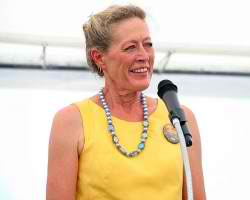After 18 months of construction, including delays, Southwestern College’s new football stadium was officially unveiled to the community during a rededication ceremony Aug. 15 on campus.
Taking the speakers podium in front of the newly rechristened Chet DeVore Stadium were Dr. Melinda Nish, the college’s superintendent/president, athletics dean Terry Davis and other college board members and dignitaries.
The stadium is named in honor of DeVore, the college’s president from 1962 to 1981. DeVore, who died in 2011 at 92, helped found the Pacific Coast Athletic Conference in which Southwestern competes and was among the county’s most successful high school football coaches with a 40-3 record.
In honor of DeVore, the PCAC annually awards the Chet DeVore Trophy to the member community college with the most successful men’s and women’s athletic teams for the academic year.
Grossmont College claimed rights to the coveted trophy in 2013-14; Southwestern College won the trophy in 2010-11.
On hand for the rededication ceremony and ceremonial ribbon-cutting were 32 members of the DeVore family. John and James DeVore, sons of the stadium’s late namesake, also were among the featured speakers.
“Our father would have been honored to be here,” explained John DeVore, the first principal at Olympian High School when it opened in 2006 and for which that school’s football stadium is named. “He had a passion for sports; sports to him were a chance to develop character. His ideals as a coach were to play hard, play with integrity and win with dignity. Teamwork and discipline were foremost among his coaching philosophy.”
Nish called the new stadium complex and other improvements made to the campus through funds available from Prop. R a “milestone in the history of the college.”
“It will be a fabulous facility for our students and our faculty,” Nish said. “It’s a new gateway for students in our college.”
Davis has served 27 years at the school, including 15 years as athletic dean. He noted that about a third of the college’s area is reserved for athletics.
“This is the new home of our community,” Davis noted. “ I’ve followed the construction at every stage. It is a building to inspire generations to come. You only get one chance every 50 years to do something like this and, with the things we’ve done, we’re looking forward to the next 50 years, not tomorrow.”
The finished product rivals the athletic complexes of most four-year universities, and it’s not quite finished. Plans are for a health awareness center/swimming pool and new gymnasium to be built on the vacant lot adjacent to the stadium.
The Olympic-size pool will instantly become the crown jewel of South County aquatics when it is completed.
The new facilities, highlighted by the four-story field house/classroom building, should serve as a major motivating tool for area student-athletes to complete their studies and make the jump to the next level.
“We consider our athletes to be student-athletes,” Davis said. “The student aspect comes first. We want them to graduate and transfer to four-year colleges.”
Davis said among the things that went into the design of the new field house/classroom complex were tours of existing facilities at four-year universities to determine optimum efficiency and usage of space.
“We asked them if they had to do something different, what would they do … and the unanimous response was to build classrooms,” Davis explained.
The complex, which is easily accessible for students, includes classroom space for 78 sections as well as expansive weight-training rooms (one with specialized equipment for disabled students and another for athletic teams), locker rooms, training rooms accessible directly from the field, a 150-seat theater/lecture hall and coaches offices.
There is more. The new artificial turf field is estimated to save more than 1 million gallons of water each year.
The building, which is designed for student comfort with tables in place of desks, has been certified as LEED silver and, now upon completion, will be submitted for gold certification.
Moreover, the college lost no real estate in building the stadium. Nish and other board members were especially proud of this fact.
“This is not an athletic building; this is an educational building built in the stadium,” Davis explained. “If we can get our students to understand this is what a four-year college is like, then we have hit our goal.”
Everyone who took the speakers platform emphasized the impact of the new stadium would transcend far beyond simply the sports teams that use it but serve as a mecca to draw new students to campus to pursue academic as well as athletic careers.
Academics and athletics are firmly tied together with the completion of the new building.
This is something that has obviously caught the attention of the Sweetwater Union High School District, which serves as the primary feeder system to Southwestern College.
Seated in the spectator gallery at the Aug. 15 rededication ceremony were three Sweetwater district administrators with past ties to the college.
Southwest High School Principal Lee Romero and Olympian High School Principal Elaine Leano both attended Southwestern as students while Chula Vista High School Principal Mary Rose Peralta taught classes there at one time.
“This is huge giving our kids something to play in,” Romero said. “ This is a big recruiting tool for our kids to go here, and for us to send more of our kids here.”
The refurbished stadium will also allow high school graduation ceremonies to return to SWC, Romero noted.
“We’re really excited about that,” he said. “It gives our parents a chance to attend. It’s more intimate than Sleep Train Amphitheatre has been.”
Sweetwater district interim superintendent Dr. Tim Glover was also present at the Aug. 15 event.
Leano noted that Olympian High School served as the Southwestern football team’s alternate home for two seasons while stadium construction was ongoing at the college.
“We were very happy to help them,” Leano explained. “I’ve always felt a connection with Southwestern.”
The connection to the community is now complete.
Peter Kluch contributed to this story












